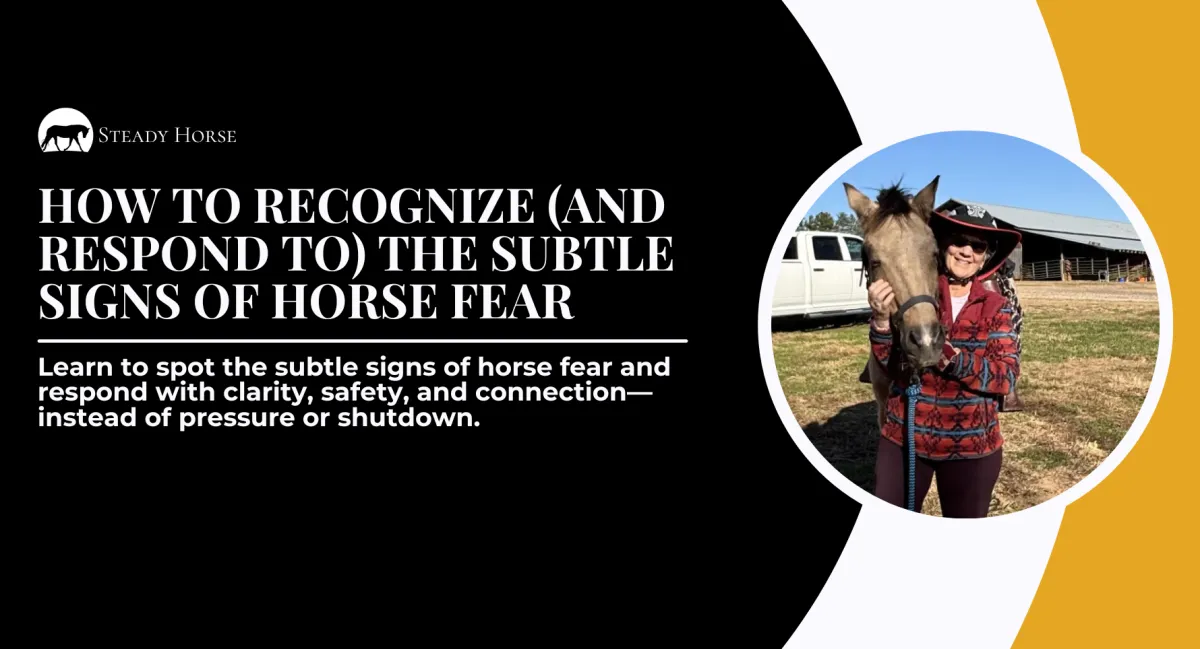
How to Recognize (and Respond to) the Subtle Signs of Horse Fear
🐎 Why Paying Attention Matters More Than You Think
It’s not always the big spook, the rear, or the bolt that tells you your horse is afraid. More often, fear shows up in the small things—subtle shifts your horse makes to say, "I'm not sure about this."
If we miss those early signals, we risk pushing our horses past their threshold. But if we tune in early, we can build confidence instead of triggering shutdown. That’s the heart of the new way to desensitize: not just exposing our horse to pressure, but guiding them through it with clarity, trust, and timing.
👀 The Hidden Signs of Horse Fear
Fear in horses doesn’t always look dramatic. Here are a few of the quieter signs your horse might be feeling unsure:
Shifting weight forward as if preparing to move away
Raising their head suddenly or locking their neck
A quick flick of the ear away from you
Holding their breath or nostrils going still
Tight muscles or a swishing tail
Eyes that go wide, hard, or disconnected
These might seem like "nothing" in the moment—but they are your invitation to step in.
🧭 Position, Direction, and Energy: Your 3 Tools for Clarity
As Rebecca Carney teaches in her sessions, the three foundational tools for creating safety and confidence are:
📍 Position
Where you stand matters—for your horse’s understanding and your own safety. When desensitizing, stand at a 45-degree angle from your horse’s shoulder with a high rope hand. This keeps you clear if they spook and lets you float with them as they move.
👉 Direction
Are you aiming your energy at their body or past it? Subtle shifts in direction tell your horse what you’re asking. Keep your energy rhythmic and consistent—not erratic or escalating. You’re not chasing them; you’re inviting them to stay.
⚡ Energy
This might be the most misunderstood piece. Rebecca points out that we need to stay present enough to reduce pressure the moment our horse softens or shows even the slightest effort to relax. That’s the reward. That’s what teaches them they made the right choice.
🧘🏼♀️ What to Do When Fear Shows Up
If your horse shows signs of anxiety, here’s what to do:
1. Adjust your energy
Don’t just keep going harder. Back off slightly—not all the way, just enough to help them find a better answer.
2. Stay present and reward softness
The moment they exhale, blink, or tip their nose in, pause. Rub. Let them rest. That’s how connection is built.
3. Don’t let well-meaning advice override your instincts
Rebecca reminds us: you know your horse best. Not every horse benefits from "keep going until they settle." Sometimes, that just leads to shutdown.
🐴 Real-Life Story: When Desensitizing Becomes Connection
Rebecca shared a story from a hot day when she went out to hose down her herd. Two horses walked right up and stood like statues, asking for the hose. Her mule, however, waited until the others were done, then walked himself into the barn aisle and stood waiting by the cross ties.
He wasn’t avoiding the hose. He wanted to be hosed down—but in a way that felt safe to him, away from the "knuckleheads."
He knew what he needed.
And because Rebecca paid attention, listened, and followed him into the aisle, he got to have that experience in peace. That moment was desensitizing—but more importantly, it was connecting.
🔁 The Real Takeaway
Desensitizing is not about getting your horse to "deal with it."
It’s about teaching them that you are safe, present, and trustworthy.
When fear shows up, your job is to notice. Soften. Adjust. And reward the try.
That’s how confidence is built. One small sign at a time.
📣 Ready to Stay Safe and Connected in the Saddle?
If you want a more intentional approach to fear, trust, and desensitizing, we’ve put together a free training that walks you through it step-by-step.
Join us at steadyhorse.com and start the journey toward a safer, more connected partnership.